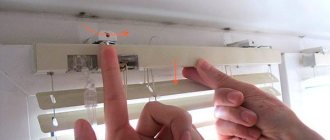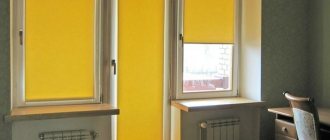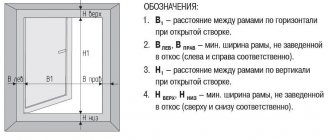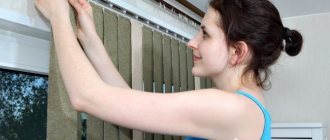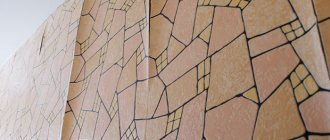Carrying out measurements and calculations
In order to create the perfect decoration, you need to know how to calculate the tulle for the window.
To measure the window opening, it is better to use a steel construction tape. With its help you will carry out calculations accurately. Also consider the height of the cornice and the presence of rings that attach the material. It is best to attach the curtain in advance in order to correctly calculate the length and not make a mistake with the size of the fabric.
It is better to take measurements not with a centimeter tape, but with a steel construction tape. Thanks to its density, calculations will be carried out more accurately, and the error will be minimized.
Write down all the numbers so as not to make mistakes in the formula. Measure the length of the cornice, the height of the window, taking into account the method of fastening.
A special curtain tape will easily help you attach the tulle to the cornice. Attachment is also possible thanks to loops, eyelets, pencil waves, triple pleats and buffers.
It is advisable that the cornice be attached to the wall before calculating the footage of the required canvas.
Correct measurements
An important step in calculating the material for curtains is the correct measurement of the window.
The length and width of the curtain depends both on the parameters of the window and on the height of the cornice relative to the floor.
There is no general formula for calculation and it will be individual for each type of fabric. For the most accurate calculation, you need to know the following parameters:
- cornice length;
- curtain width;
- curtain length;
- the necessary supply for sewing on the braid;
- repeat of the drawing.
Rapport is the distance between repeating elements of a pattern. You need to know this so that when cutting the curtains, both canvases turn out identical.
It is better to take measurements using a metal tape measure. Tailor's cm is not very accurate and convenient.
Using the formula, you can calculate the fabric consumption per bow fold, then multiply the resulting footage by the number of planned folds.
So, everything is clear with the terms, we can move on to measurements.
- Length of cornice. It is important that by the time you calculate and purchase the fabric, you already know exactly which model will hold the new curtains. If the cornice is wall-mounted, its length is measured strictly from tip to tip, height - from the top border of the tube to the floor. If the cornice is ceiling, the length should be measured from edge to edge, and the height - from the bottom edge to the floor. You should not take measurements “by eye”; fix the cornice on the wall and only then pick up a tape measure.
- Curtain width. The length of the cornice from tip to tip is taken as a basis. If there are two curtains, the value must be divided in half.
Selection of tulle size
How to understand what size the tulle should be for a specific width of the translucent curtain. For a light veil the coefficient is 1.5-2. For a dense and durable texture it is calculated as follows:
- With a cornice length of 3 meters, 6 centimeters are added for allowances. With a coefficient of 1.5, you get 4 meters and 56 centimeters of fabric ((300*1.5)+6).
- If the fabric is light, then you can allow yourself to create a beautiful wave.
- With a cornice length of 3 meters, 6 centimeters of allowance and a coefficient of 2, you get 6 meters and 6 centimeters of material ((300*2)+6).
The size of the window is not the only thing that determines the size of the material needed to create a given product. A significant role in calculating the size of the fabric is played by the type of desired fastening and, as a consequence, the gathering factor.
For small windows
Small window openings can also be beautifully decorated. In this case, a person can show maximum imagination and courage. A small window allows you to combine things that are unacceptable for larger ones.
Knowing the width and length of the fabric that is needed to create the product, it is necessary to add a certain amount of material based on the processing of the edges.
Creative options for a small window opening:
- Grandma's tulle. You've definitely read about him in books or seen him in films. A country house is often decorated with this type of curtain. Everything is secured using an unusual cornice that you can create yourself. The tulle is decorated with large bows of the same material.
- Sliding tulle. Almost any fabric will work here. Match with furniture or walls.
- Roman or rolled tulle. An unusual combination of colors will help you decorate your home in a stylish and modern way.
The length of the curtains is measured from the top of the curtain rod to the point where the fabric will end.
2 meters per window
In order to measure the amount of canvas per 2 meters of cornice height, you need to decide on the type of wave. How much tulle do you need for a 2-meter cornice? Knowing the fold coefficient, you can easily calculate the size. If the wave should be with a coefficient of 2.5 (glass shape), then the calculation is as follows: (2 * 2.5) + 6 centimeters at the edges. You will get 5 meters and 6 centimeters of fabric for a 2 meter window.
The number of centimeters required for allowances is added at the last moment, when the width and length of the future product are calculated.
3 meters
People are often interested in how many meters of tulle are needed for a 3-meter window, because the width is mostly standard and depends more on the assembly of the waves. The span is chosen from 4.5 meters to 9. Please note that the width is measured not by the distance between the frame, but by the length of the cornice. You should also take into account decorations, such as knobs.
If the cornice is three meters, then it is worth deciding on the type of fold and calculating it using a special formula. Once you know the fold coefficient, you can find out the width of the tulle to sew.
When calculating the width of the tulle, not only the length of the cornice is taken into account, but also the characteristics of the fabric.
If you want to create a curtain with a goblet wave, then the formula is: 3 meters * 2.5 (this is the coefficient of the goblet fold). The result will be 7.5 meters. To this figure we add another 6 centimeters to the edges. It turns out that for tulle with a goblet wave you need to purchase 7 meters 56 centimeters of fabric.
Calculation of tulle along the cornice
To calculate the length of the cornice, you should find out about the filling.
If you plan to select fabric for a particular fold size, you need to know the tulle gathering coefficient. It will help in calculating the footage that will be needed for a particular drapery.
Note! Filling is one of the important elements in calculation. The resulting pomp of tulle will depend on this.
Filling can be of the following types:
- Small. This is a minimal build. Experts say that it is impossible to take less than 1:1.5. If the window width is three meters, then you will need fabric: 3 * 1.5 = 4.5 meters. You can take less, but keep in mind that you will end up with an inconspicuous curtain.
- Average. Here take the ratio 1:2. If the window is three meters, then 3 * 2 = 6 meters of material are needed. Most often, clients choose this type of filling because it creates a beautiful design with small but even waves.
- Full. The luxury of this filling is calculated using the formula: 1:3. This tulle will look lush and rich. If the window is three meters, then the fabric needed is: 3*3=9 meters. Additional information: such a curtain will look great with a large ornament or embroidery. It is better not to use drapery, because it will hide the entire design.
Folded tulle looks elegant and airy.
There are also nuances that directly affect the calculation:
- Material thickness. If the fabric is very dense, then the filling should be minimal. If you take a lush type, the room will be plunged into darkness, and the sun will not be able to penetrate into the house. If the material is very thin, then choose a large filling accordingly.
- Patterns. If the fabric has an ornament, then the minimum coefficient is also selected. If the ornament is large, then large pictures will be lost in the folds, and the design will look ridiculous.
The denser the material, the less filling should be. Otherwise, little light will enter the room. And, conversely, the thinner and more transparent the texture, the greater the filling you need to choose.
How to measure correctly?
First trick
— correct taking of measurements from the window opening. To measure it, you first need to decide on the type of length:
Important! The specified measurement rules will only show what the length of the curtain should be, but not the material consumption for it. You need to remember this fact in case the curtains are made independently, and not bought ready-made.
Second trick
- select the length of the cornice. To do this, you will need to measure the width of the window opening. The decor looks beautiful if the cornice protrudes 15 cm on both sides of the window. Suppose the opening width is 150 cm, then the length of the cornice is calculated as follows:
This is a classic calculation option. It assumes that the geometry of the room is correct. But this is rare. More often in a room, a wide window is located on a narrow wall, or a narrow window opening is lost against the background of a large wall. What to do? The imbalance is eliminated by changing the increase coefficient. For wide walls, add not 15 cm, but 17-23 cm. For narrow walls, 8-13 cm. It is better to take measurements with a metal tape measure. It more accurately and easily imitates a barbell. Place it against the wall at the height where the accessory should be attached and evaluate the view. When calculating the length of the rod, the tips are not taken into account.
Third trick
- We hang the cornice correctly. The accessory has its own specific place on the wall. The bar is attached to brackets, which are fixed above the line of the window opening at a distance of 7.5-13 cm. Typically, in apartments with low ceilings, the window opening is located almost under the ceiling. Then it is better to retreat 7.5 cm from the top line. If the ceilings are high, then the distance from the ceiling to the window line is large - 45-55 centimeters. In this case, the cornice is hung at a distance of 12.5-13 cm. We install the rod, arm ourselves with a tape measure and take measurements along a straight line.
Length selection
The most common types of tulle lengths:
- To the windowsill.
- Behind the windowsill.
- To the floor.
In most cases, tulle up to the windowsill is hung in the kitchen or children's room. In these rooms this is practical, because the curtain covers the window and does not interfere with operation.
Window curtains are an important expressive element of interior design. The perception of the room as a whole depends on their appearance.
Important: 1 centimeter of the edge of the tulle should not touch the window sill so that the product can move freely. You can also use the canvas up to the window sill in the room in which you want to use the stove for a special purpose.
The tulle below the window sill looks more elegant and beautiful. Add 10-15 centimeters to the height of the slab so that the curtain hangs evenly.
Curtains of bright colors are suitable for a white kitchen.
Advice. If you choose tulle for the floor, keep in mind that it should be one centimeter higher than the covering. This way you protect it from dirt and wear. If you have a large living room, no pets or small children, then you can decorate the room with long tulle.
We take into account all the details
The width of a roll of light fabrics (such as tulle, organza, veil) is usually 2 m 80 cm. If the height of the future curtain fits within these figures, then it is not difficult to calculate the number of linear meters required when purchasing.
The situation with curtain fabrics is more complicated - their rolls come in different widths: 1 m 40 cm, 2 m 80 cm, 3 m. In the case when the height of the curtain (in other words, its length) fits into the width of the roll, the footage is determined in the same way as indicated.
If the width of the roll is less than the length of the curtain, then the curtains will have to be sewn together from several pieces of fabric. In a financial sense, it is more burdensome. The number of canvases will also depend on the assembly coefficient and the pattern on the material. When connecting the canvases, the pattern must match - you will need additional centimeters to match the pattern.
If the curtains have a large print, then the number of meters purchased increases by the height of the repeat - a repeating pattern. And this applies to every panel. For example, both curtains have a total length of 5 m. The height of the repeat is 30 cm. We calculate how many meters of fabric will have to be purchased: 5 m + 30 cm + 30 cm = 5 m 60 cm.
Calculating the size of a curtain for a window seems difficult only at first glance. Difficulties disappear when you know how to do it.
Source
Width selection
How to calculate the width of tulle. The basic figure is also the length of the cornice. In the living room and hall, wide tulle is most often chosen, which covers the entire window surface. Consider the walls that the curtain must cover. Here everything depends on the depth of the waves, so we use the same formula.
The type of folds depends on the quality of the curtain material.
Additional Information! To save material for a 3 meter cornice, choose fabric measuring 5 meters. There will be a main fabric in the center, and the edges can be decorated with curtains.
Features of window design with tulle
If you gather the tulle into beautiful waves, then it will all look luxurious and relaxed. Previously, folds were created independently. But now there is a special tape for tulle that will create smooth waves quickly and effectively.
Light curtains are made from translucent materials and do not shade the window too much.
This ribbon looks like a strip of lightweight material with laces. If you sew the ribbon to the tulle and tighten the thread, the waves will be smooth and beautiful. You can attach it thanks to textile loops, which in turn are sold with hooks.
For tulle it is better to choose a transparent ribbon. On light fabrics, such as organza or mesh, it will be invisible. Curtains and thick materials look better and are held on strong fasteners.
Colored curtains will create a bright accent and add variety to the interior.
Note! Durable fabric is made from natural material - cotton. Buy more tape than you need so that after washing it can shrink by 10-15 percent of the original size. You can also steam it before sewing.
There are different types of tapes that create a custom fit.
- Uniform waves. After you tighten the lace, the fold will be a straight pencil.
- Boof. This wave is also called a waffle, because it is very similar to sweetness.
- Glass or shot glass. The relief resembles an interesting goblet-shaped wave.
- Bow. Equal wave bows are produced on the material. It is impossible to do this without tape and experience.
- Goose feet. Triple and uniform wave on the fabric.
Light tulle can replace the usual thick curtains.
In the kitchen
It is recommended to choose a simple translucent tulle for the kitchen. Available in a single color with a small ornament. The main thing is that the chosen product gives comfort and peace of mind. Prepare veil, organza, and smoky mesh. It is necessary that the fabric does not deteriorate from the color of the sun and does not get too dirty.
Classic curtains with floral patterns are also allowed in the kitchen.
In the children's room
The children's room is filled with bright and bold colors. The tone of the tulle is selected to suit the child’s tastes, so you don’t have to be limited. Pastel colors, white tulle, large patterns and lush bows will decorate the room. If the child is small, then it is best to choose a short curtain so that the baby does not tear it and gets less dirty. For older children, curtains can create a real kingdom.
3D curtains with images of cartoon characters are perfect for a child's room.
In the bedroom
For the bedroom the range is quite wide. Manufacturers offer many options for colors, shapes and designs. A veil, light organza, viscose and tulle will fit perfectly.
Beige curtains will suit a green bedroom.
In the living room
For the living room, it is recommended to use light translucent tulle, which allows light and air to pass through well. It can be combined with a curtain, lambrequin, drapery, embroidery and lace. Multilayer products in different shades are considered relevant.
For textured wallpaper, brighter curtains with the same texture are selected.
In the hall
If the curtain will be the main element in the room, then choose a rich and bright fabric. If this is an addition, then buy an inconspicuous light canvas. Consider the overall design of the room. If you prefer the classics, then lambrequins, flounces and tiebacks will fit perfectly. If you want to adhere to minimalism, then pay attention to texture and color. Almost any tulle is suitable for the hall, the main thing is that it matches the overall picture.
Curtains should not blend in with the wallpaper.
We calculate wisely
How to calculate the fabric for curtains - such a task seems difficult to accomplish, but this is only at first glance. You just need to know that the required footage is determined by the sum of several terms:
- curtain length,
- width multiplied by the build factor,
- allowances for processing edges,
- allowance for possible shrinkage of the fabric,
- reserve for the symmetry of the pattern if the curtains have a large repeating pattern.
Measurements are more accurate when using a long metal tape measure rather than a flexible measuring tape.
Attention! It is possible to calculate the fabric for curtains correctly only after installing the curtain rod and measuring its length and the interval from it to the floor (or window sill).
Calculation of fabric length
First, find the distance from the cornice to the desired end point - the floor or window sill. This will be the finished length of the product. According to the wishes and ideas of the home owners, curtains can:
- reach the floor, 1-2 cm without touching it to avoid wear,
- reach the floor and lie on it with a “trail” of 5 to 10 cm,
- be the length of the window sill, without reaching the bottom edge of the curtain to its surface by 1 cm,
- fall below the window sill by 10-15 cm.
Then, for a more accurate calculation of the fabric, you need to know the method in which the curtain will be hung on the cornice. There are several types of fastening:
- A special curtain braid, the loops of which will catch the hooks of the curtain rod. Two strong threads are stretched along the ribbon for a neat and beautiful assembly of the fabric. If, for example, the braid is 7 cm, you will need 14 cm of fabric for a double hem. Plus 2-3 cm on the side at the top.
- Loops or ties sewn to the top finished edge of the curtain.[adinserter block=»2"]
- Clothespins, clips, hooks. In this and the previous cases, a technological allowance of 2-3 cm is given to hem the top of the fabric.
- The drawstring is a kind of tunnel along the top of the product through which the rod of a round cornice or string line passes. To the total footage you will need to add the double width of the drawstring (it can be from 3 to 20 cm).
- Eyelets are plastic, wooden or metal rings driven into holes along the top of curtains. Then the width of the lining tape (from 10 to 20 cm) is added to the total number of meters, which is glued from the inside to seal the fabric and allow the eyelets to move along the rod.
Build factor
If you have fabric and you know what type of fold you want to see on the tulle, then you need to calculate the gathering factor. This will help you know how much fabric you will need to create the waves. The footage determines the width of the material. The resulting splendor of the folds depends on correct calculations.
Before you start calculating, you need to measure the length of the cornice and the model of the braid.
Cutting the curtains will be quite simple.
The width is calculated very simply: fabric size = gathering factor multiplied by the length of the cornice.
Decide on the type of wave, because each type requires a different formula:
- For a pencil, the build factor will be 2.5-3.
- For buffs – 1.5-2.5.
- Goose feet are formed at a factor of 2.
- Glasses and bows – 2.5-3.
By calculating the assembly factor (AC), you will find out the necessary measurements of the material. It is calculated like this: we multiply the coefficient by the length of the cornice. For example, the coefficient is 1.5, and the length of the curtain is 300 centimeters. This makes 1.5*300 = 450 centimeters (4.5 meters of fabric).
Curtains should fit harmoniously into the design.
Take into account the presence of the side seams of the curtain. Leave 3 centimeters on each side of the tulle. That is, if you follow the example, then 4.5 + 6 centimeters = 5.1 meters.
Using short curtains
In some rooms it is unwise to use a long curtain, as well as in small houses. Therefore, they choose short curtains, which are no worse than lush long ones, and in some cases even look better. Pros of short tulle:
- open access to the windowsill.
- direct access to the air.
- ease of care.
- less polluted.
- less material required
Arch curtains are convenient for a small room, as they do not take up much space.
Small curtains are available in a variety of designs and colors. Light airy curtains are suitable from a voile, and for the Austrian style buy cotton fabric. With such tulle it is easy to stylishly decorate a window, because the material is quite soft, and uniform waves are created automatically.
The width and height of the tulle is extremely important for the overall picture of the room. Look at photos on the Internet and decide on the type of wave. There is no need to rush and take it “by eye”. Calculate everything correctly and enjoy style and comfort.
The third point is the installation location
Each room creates a unique environment. For example, the bedroom should have a relaxing atmosphere. Therefore, it is necessary to buy tulles made of denser fabric with darker shades. They should be longer and wider than standard sizes to create a cozy and warm feeling in the room.
The kitchen requires a fresher environment as it hosts various activities throughout the day. Therefore, in this room you need to hang shorter and narrower curtains, with bright colors.
In the living room you can experiment without restrictions. The main thing is that the tulle matches the interior and does not look pretentious.



